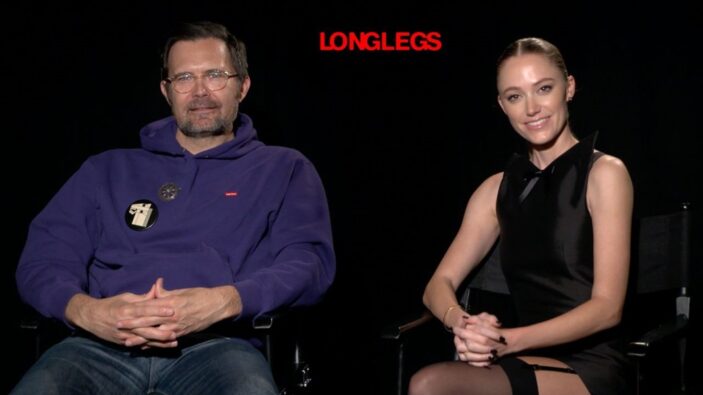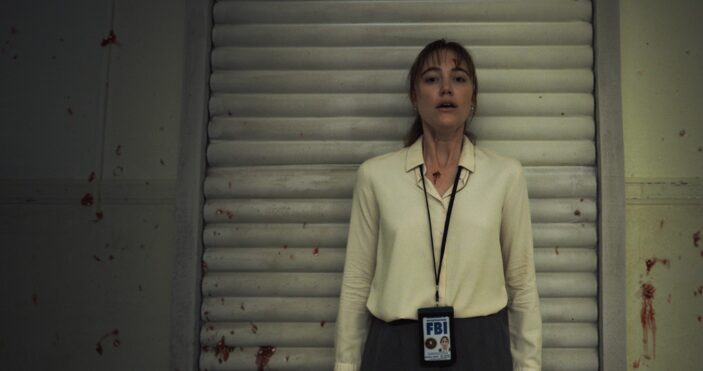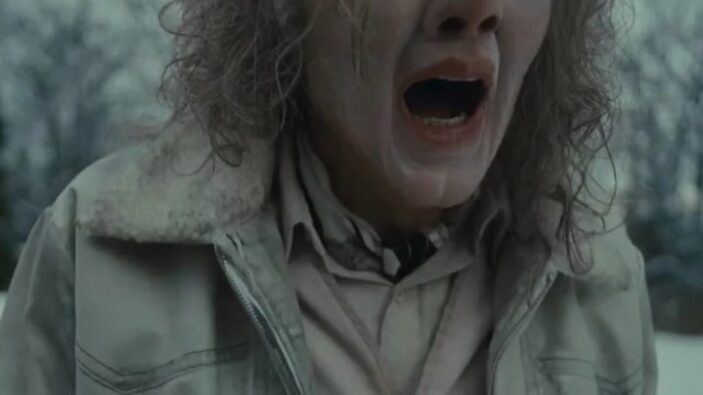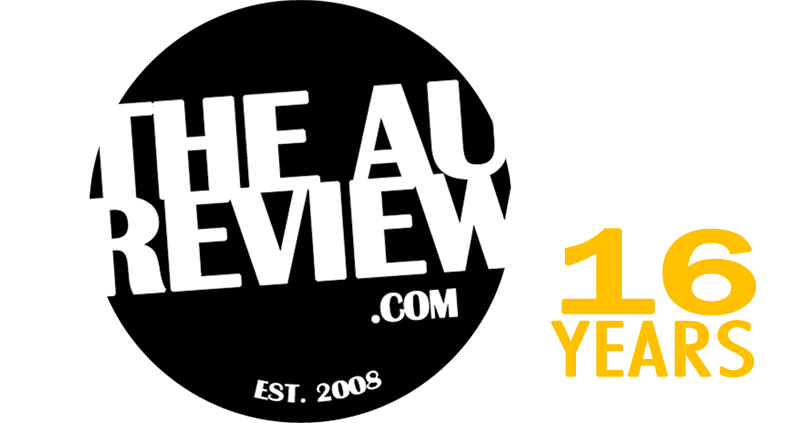
Recently crowned the #1 movie in America* (*behind Despicable Me 4), Longlegs broke barriers as indie distributor Neon’s biggest debut ever with over $20 million in ticket sales.
A winner with both audiences and critics, the terrifying thriller – that’s been hailed as the “Best serial killer horror film since The Silence of the Lambs” – tells of FBI Agent Lee Harker (Maika Monroe) as she uncovers a series of occult clues that she must solve to end a serial killer’s terrifying murderous spree.
As it gears up to terrify Australian audiences this week, our Peter Gray spoke with Monroe and writer/director Osgood Perkins about crafting their killer narrative and working opposite an intense Nicolas Cage.
Osgood, when you’re conjuring up a story such as this, what is it that comes to mind first? The nightmarish imagery or the narrative itself?
Osgood Perkins: It’s what I think would be most fun about something like this, and that usually comes through in the music, and then the imagery evolves as you work with other people. The first thing that happens is the dialogue and the way the movie sounds, and what people are talking about and what words they’re choosing to use. I’m a big words guy. I don’t believe in thinking about writing. I only believe in actually writing. Those are very different entities to me.
It starts with the words, and it starts with the words that I like. And it starts with the title, like “the long legs that I like”, and then it starts with the way (Nicolas Cage) talks and the things he chooses to say. It grows out of that.
Without spoiling what happens, the opening scene is such a great set-up, and the closing shot is a chef’s kiss on the film. As you’re crafting the narrative, when are you figuring out your opening and closing?
Osgood Perkins: The opening scene was the first thing that I had, because you want your first movement to contain the entirety of the (story), right? It’s like all of civilization contained in a grain of sand, or whatever. Your first movement should be, in a way, the whole picture. When I had a much longer screenplay, it was a much longer scene. We ended up piecing it out and using parts of it towards the end, but he sticks around and has quite a long scene with Alicia Witt’s (character). They talk about his visit and what that means.
Maika, I wanted to ask you about creating your character’s inner voice. She’s not just someone trying to solve these murders, but she’s trying to find out something about herself that she doesn’t quite understand. A lot of that comes through your facial performance. I’m curious as to how you developed that.
Maika Monroe: I think it really began going backwards to her childhood and (that) childhood trauma. Obviously she has a lot of suppressed (memories), things that she has blacked out of her mind. I think it was fun to play with where you could slowly start to have some of these memories boil to the surface. Obviously it’s a slow burn with that, and then it slowly starts to crumble.

I understand that when your character first sits across from Nicolas Cage’s that, Maika, that was your first time seeing him in all his make-up’d glory. I wanted to ask you Osgood, in terms of creating the aesthetic of that character, how much of that is you and how much of that Nicolas?
Osgood Perkins: We worked on it together. Of course there’s the contribution of hair, makeup, special effects, wardrobe, production design…everybody’s pulling towards the same goal, which is to make something cool. Something that has a music to it. That has a pulse. A vibe that’s stronger than anything else around it. That’s the whole trip we’re on.
With Nic, the character of Longlegs, most of it is on the page. The way he looks is written, and then we just have to figure out a way to make it look right. It then becomes about literally taking one piece at a time. Like the chin, is it too much? It looks like Dick Tracy, so we take it down by half. I don’t need these kind of scars around the eyes, because that makes it look a little too much like a Halloween costume, so let’s take that down. The hair should be poofier. We’re talking about glam rock, so let’s make it kind of exaggerated a little bit. It just becomes about taking all the little pieces and sewing them together. Luckily, for me, I have a collaborator in one of the all-time great movie presences who’s really as focused and deliberate and deep as you want them to be.
I think, for me, (the character) always starts with Darth Vader, right? And everything kind of goes from there. And when I say it starts with Darth Vader, it starts with the quality of the villain being the star of their own story. The star of their own situation. They’re doing the best they can with what they’ve been dealt, right? And with someone like Longlegs, how do you make him sinister? But what part of him isn’t sinister?
You pull and stretch that rubber band, like, where is he pathetic? Obviously he’s powerful, but where is he weak? He’s invested, but where is he unsure? You start to create these kind of binary positions where much more can exist between those poles. Everybody has their pluses and their minuses, and I guess a serial killer is ultimately still a person who shit has happened to, and when you pluck them out of their habitat, they’re probably pretty pathetic.
Maika, when you’re working opposite Nicolas Cage, are there moments of levity? Is he staying in character between takes? Does he break character? How intense an environment is it to shoot in?
Maika Monroe: Yeah, it definitely felt intense. Pretty much we would do a take and I would just step out of the room and, you know, Oz would go in if there were notes or something. But I think it was nice for (Nic and I) to keep our space. After we’d finish filming for that day, and it was actually his last day, we were sitting across from each other and they were taking some still photos, and we just started chatting. It was the first time I heard (Nic’s) actual voice, and he was saying to me that he was such a fan. “I love all your movies.” I just sat there, like, “Is this really happening?” It was very surreal.

And you’ve made quite your mark as an actress within the horror genre. It Follows, The Guest, Watcher. Do you think your Agent Lee Harker would’ve been able to solve any of those characters’ particular cases?
Maika Monroe: You mean if we put Lee in It Follows or Watcher? Yeah, I have full confidence in Lee. I don’t know about the other way around (laughs), but I have confidence. Right?
Osgood Perkins: Yeah, she’s got an unfair advantage. An other worldly advantage.
Maika Monroe: That’s true. I think she would do alright.
Osgood, when the trailer for Longlegs came out, I felt like we saw all this conversation around the fact that you’re “that guy from Legally Blonde“, but we also know you from Six Degrees of Separation, Not Another Teen Movie, Nope…was directing something you always knew you wanted to go into? And genre directing, for that matter, was that always your intended niche?
Osgood Perkins: I think, like any kid that grows up and sees their dad doing the thing, there’s the sort of raging impulse to do the same thing. Do a little bit of detective search on your dad by trying to go in the same footsteps. I think, for me, it was certainly part of that. (For the uninitiated, Osgood is the son of Psycho actor Anthony Perkins). The horror genre, to me, is the just the most delightful. It’s the most delicious. It’s the most profane and absurd, romantic, poetic, endless concealed genre of all of them. It really contains everything. It contains love and comedy. It contains adventure and science fiction. It’s all embedded in there.
I don’t necessarily think of myself as a horror director because I don’t know that I think of myself as a horror fan. I can’t remember the last horror movie I paid to see in the theatre, because I really don’t care about (it). To me, I’m more looking to do something sort of expansive, and the horror genre allows for all realms of thought and expression. There’s so many little signifiers that you can connect to, like a serial killer or procedural crime, or an axe murderer, or whatever it is. You can kind of go in and people have an idea about it, and there’s an emotion attached to it. Then you can create your own thing based on that model.
Longlegs is screening in Australian theatres from July 18th, 2024.
